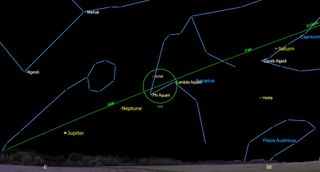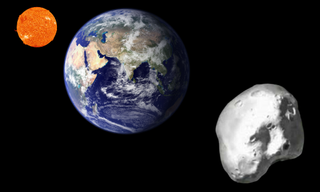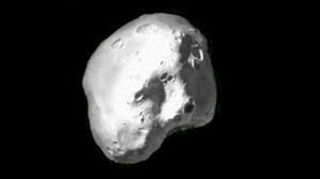Massive asteroid 3 Juno shines in opposition on Wednesday (Sept. 7)
One of the largest asteroids ever discovered, Juno will be identifiable by its silver-colored glint most visible at around midnight.

Wednesday (Sept. 7), will give sky watchers an exciting opportunity to see a giant silver asteroid shining in the sky when the asteroid 3 Juno (Juno) moves opposite the sun.
The best time to see the asteroid, an inhabitant of the main asteroid belt between Mars and Jupiter, will be around midnight. The asteroid, which takes its name from a Roman goddess, will appear in the constellation Aquarius remaining above the horizon for the majority of the night. Juno will be visible over New York from 9:06 p.m. ET (0106 GMT on Sept. 8) when it will rise to 21⁰ above the south-eastern horizon until 4:35 a.m. ET on Sept. 8 (0835 GMT), at which point it will sink towards the horizon in the southwest. (A fist at arm's length corresponds to around 10⁰.)
The optimal time to catch the asteroid will be at 12:51 a.m. ET on Sept. 8 (0451 GMT) when it will be at its highest point in the sky and will also be directly opposite the sun at 45⁰ above the southern horizon — the point described as opposition.
Related: Night sky, September 2022: What you can see tonight [maps]
At this time Juno will also be making its closest approach to Earth, passing to with about 120 million miles (193 million kilometers) of our planet, meaning that the asteroid will be at its brightest for astronomers reaching a magnitude of around 7.8.
Despite this, 3 Juno still won't be visible with the naked eye, requiring a telescope or binoculars to spot.

Juno was the third asteroid to be discovered when it was first observed by German astronomer Karl Harding in September 1804.
Get the Space.com Newsletter
Breaking space news, the latest updates on rocket launches, skywatching events and more!
Juno is one of the largest asteroids in the main asteroid belt with an estimated diameter of around 145 miles (233 km) — about a fifteenth of the diameter of the moon. This also makes Juno the tenth or eleventh largest asteroid that astronomers are aware of.

The asteroid is also estimated to possess a mass of around 2.7 x 10¹⁹ kilograms (that's 27 followed by 18 zeroes) which means it alone holds around 1 percent of the total mass of the main asteroid belt.
Juno has an irregular shape and an unusually high surface reflectivity for a rocky asteroid which gives it a distinctive silvery glint. The surface of the asteroid is scarred by craters left behind by impacts with other smaller space rocks.

Looking for a telescope to see asteroid 3 Juno? We recommend the Celestron Astro Fi 102as the top pick in our best beginner's telescope guide.
These impacts often break fragments off Juno, and the asteroid is believed to be responsible for many of the meteorites that rain down on Earth according to NASA. This is in part due to the fact that the silicates Juno is composed of are hardy enough to survive a trip through our planet's atmosphere.
Juno orbits the sun in a highly elliptical (flattened) circle completing a full orbit once every approximately 4.4 Earth years. The asteroid is traveling at an average speed of around 40,000 mph (64,374 kph); that's almost 20 times the speed of a bullet fired by a rifle or 30 times as fast as a Lockheed Martin F-16 jet.
On Wednesday (Sept. 7), both Earth and Juno will be on the same side of the sun with the three astronomical bodies lining up with Earth in the middle.
You can check out our guides for the best binoculars and the best telescopes to spot asteroids like 3 Juno. If you're hoping to capture a good photo of the space rock, check out our recommendations for the best cameras for astrophotography and best lenses for astrophotography.
Follow us on Twitter @Spacedotcom or on Facebook.
Join our Space Forums to keep talking space on the latest missions, night sky and more! And if you have a news tip, correction or comment, let us know at: community@space.com.

Robert Lea is a science journalist in the U.K. whose articles have been published in Physics World, New Scientist, Astronomy Magazine, All About Space, Newsweek and ZME Science. He also writes about science communication for Elsevier and the European Journal of Physics. Rob holds a bachelor of science degree in physics and astronomy from the U.K.’s Open University. Follow him on Twitter @sciencef1rst.
